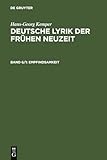Deutsche Lyrik der frühen Neuzeit. Band 6/1, Empfindsamkeit.
Material type: TextSeries: Deutsche Lyrik der frühen Neuzeit ; Band 6/1Publisher: Tübingen : Max Niemeyer Verlag, [2010]Copyright date: ©1991Edition: Reprint 2010Description: 1 online resource (568 p.) : 17 AbbildungenContent type:
TextSeries: Deutsche Lyrik der frühen Neuzeit ; Band 6/1Publisher: Tübingen : Max Niemeyer Verlag, [2010]Copyright date: ©1991Edition: Reprint 2010Description: 1 online resource (568 p.) : 17 AbbildungenContent type: - 9783484105713
- 9783110940732
- 800 831.0409
- PR509.L8 .K46 1997eb
- online - DeGruyter
| Item type | Current library | Call number | URL | Status | Notes | Barcode | |
|---|---|---|---|---|---|---|---|
 eBook
eBook
|
Biblioteca "Angelicum" Pont. Univ. S.Tommaso d'Aquino Nuvola online | online - DeGruyter (Browse shelf(Opens below)) | Online access | Not for loan (Accesso limitato) | Accesso per gli utenti autorizzati / Access for authorized users | (dgr)9783110940732 |
restricted access online access with authorization star
http://purl.org/coar/access_right/c_16ec
The discussion on the emergence of Empfindsamkeit has tended largely to ignore the lyric poetry of the period, although it may be said to be the first genre to take up and reflect this particular materialization of the Enlightenment. It displays close connections to the religious avant-garde of the period, with Pietist poetry being the first category to manifest tendencies that can genuinely be termed empfindsam. The most prominent poets of this bent are theologians with strong leanings towards Neologism, a religious persuasion reconciling within itself both Pietism and Rationalism and as such legitimately identifiable as the theology of Empfindsamkeit. This volume is the first study to point up these connections. In so doing it sheds new light on the religious roots of Empfindsamkeit and opens up an entirely new perspective on its poetry.
Um 1740 gelangen die in der Frühaufklärung noch getrennten Epochenkräfte von Pietismus und Rationalismus (vgl. Bd. 5/I u. 5/II) in enge Berührung, und dies zuerst und dominant in der bislang zu wenig beachteten Lyrik. Als Medium des Gefühls verschwistert sich diese mit den beiden religiösen Avantgardeströmungen der Zeit und wird dadurch zu einem Organ der Empfindsamkeit: Die Poesie des Pietismus entwickelt als erste empfindsame Tendenzen (Teil I). Die meisten Dichter der Empfindsamkeit - überwiegend studierte Theologen - neigen sich jedoch der 'Neologie' zu. Diese sucht, von englischen Vorbildern ausgehend, pietistisches 'Herz' und Leibniz-/Wolffschen 'Kopf' ins Gleichgewicht zu bringen und erweist sich damit als Theologie der Empfindsamkeit, in deren Reformprogramm die Poesie (von der Hymne bis zum biblischen Epos) einen hohen Stellenwert besitzt (Teil II). Die Lyrik übernimmt bis hin zu Klopstocks rituellem Gedicht in Inhalt und Form religiöse Funktionen. Dabei dient sie der Religion und emanzipiert sich doch zugleich von ihr: Einerseits wird sie in der Nachempfindung biblischer Poesie zum Sprachrohr göttlicher Offenbarung und zum Organ neologischer Frömmigkeit und Moral, andererseits und zugleich zum "Ausdruck wahrer Empfindung" und gewinnt somit - auch in der Sakralisierung ihres Selbstverständnisses und Weltbezuges - an Autonomie und modernem Gattungsprofil hinzu.
Mode of access: Internet via World Wide Web.
In German.
Description based on online resource; title from PDF title page (publisher's Web site, viewed 17. Dez 2021)


